The Origin of Religion:
The Deep Spiritual Roots of Religion
by R.E. Slater
March 24, 2023
"...the positive feelings around [the communal meal of] table-sharing were already in place. They’d already been in place since the emergence of modern humans, about 200,000 years ago.
"...And yet – Homo sapiens wasn’t the only species to discover the benefits of food-sharing. Neanderthals certainly pooled their resources, as did the several other Homo species dating back two million years.
"...Any human phenomenon that exists is a human phenomenon that became what it is. This is no less true of religion."
- Brandon Ambrosino
"Nothing is ever lost" - Sociologist Robert Bellah
I've entitled today's post "The Deep Spiritual Roots of Religion" to help fix in our minds that spiritual practices, beliefs, rites and rituals did not just drop out of the sky into our laps. That said, spiritualism is as ancient as modern man (Homo Sapiens ala L3) himself (c. 55,000-70,000 yrs ago to the present). And even as old as our primate apian relatives (c.25-19 mya = million years ago).
However, the very weight of spiritualism in many faiths can be projected even further... to the very start of creation. That the God who created creation is the God who is within-and-about creation.
What Is Meant by God As Creator?
This is not to mean that God is ontologically the same as creation but that God is present with-and-within creation to its very DNA. If God and creation are one with one another then such beliefs are described as pantheistic. However, if God is transcendent above creation then this would more describe religions similar to classic, westernized Christianity and is known as classical theism emphasizing transcendency.
A third form of thinking of God's "with-ness" in creation is a synthetism of both ontological equalitarian pantheism and transcendent westernized theism is that of pan-en-theism, which is the belief, or doctrine, that "God is greater than the universe who also is present with and interpenetrates it." This position of a panentheistic relationship between the Creator and created is tweaked by process theology to describe a process-relational panentheism of "immanency," both ontological and metaphysically.
Spirituality IS the Deep Center of Creation
Which is why we may say that the "divine spark" of God, or God's very Imago Dei, is part-and-parcel of creation. This doesn't make creation automatically holy but it does make it sacred. And it also tells us that God's presence with us - and with creation - can make this space a holy place. A loving space. A space of Eden-like qualities when all is in fellowship with its Creator.
Because of the divine Spirit of God inhabiting and presiding WITH creation we may correctly say that the qualities of love and beauty and fellowship coupled with abiding perserverance is that quality which doesn't stop with humans, or the apes, but is a quality which "goes all the way down and all the way up."
Nothing is Holy or Sacred without LOVE
One last... holiness or sacredness means nothing without God's love. If separated from divine love we simply get oppressive beliefs, cruel religious actions / deeds / attitudes / polities / dogmas / and policies; or more properly, let's just call these sinful and evil interpretations of holiness its own kind "hell on earth".
In God love comes first. All other divine qualities come second and are based on God's love... including God's act of creation. Creation is a love-gift.... It is NOT meant to be an abomination of the holy upon the loving nature gifted the created. Any proper description of the sacred or the holy is always preceded by the love of God.
This divine qualities of merciful grace, forgiveness, and self-sacrificial-service cannot be added to or subtracted from when man's idolatrous heart seeks to displace divine love by divine enmity and wrath. God is not this. God is love. The holy and sacred only find meaning in LOVE.
Christianity, like Many Other Faiths Are Bankrupt
What do I mean by this?
That any faith or belief or religious system which puts idolatrous loyalty to the church, the institute, the doctrine or system have replaced God for man's idea of God.
Humanist systems are similarly fraught with this deep contradiction whenever they loose sight of people for policies, systems, or indoctrination.
God's Love places people, like nature, on the priority list... that is, we are too embrace one another - including nature - in love and by loving relationships full or loving words, deeds, acts, and helps.
The church, like any other religion, is merely religious when love is no longer the center standard of its faith.
Jesus said and taught the same. Jesus' live proclaimed God's love upon the Jewish religion so fiercely protected by the priests and scribes and religious culture. But the priests and scribes and Jewish culture was bankrupt with God's love. And by its "holy" concerns and "sacred" perfidies it shouted back to God it's abominations.
Jesus died because of the religiously "faithful" protecting their turf. Their "unsacred" beliefs. Their "unholy" acts. They blasphemed God by killing the God of Love in their midst.
And what did the God of Love do? God turned his people's blasphemous acts into one of loving atonement, renewal, reclamation, and redemption.
As God had once demonstrated to (Father) Abraham eons earlier, by God's Self is God's covenant with Abraham and his descendants made whole, protected, sealed, and secured as God walked between the "laid-out halves of slain carcasses". Here, the Suzerain said to the vassal, "You are mine - not by your acts but by mine!" So too Jesus did the same once again on Calvary's Cross.
Below is a very good article on primitive faith and discussion of the possible roots of religion. However, even those these suppositions are lost to us it doesn't mean they are no longer extant.
Rather, any good sociologist can say the same in our present contexts. Look for the loving and meaningful and in them can be found the beauty of the Lord who is ever present with us in all ways.
Peace,
R.E. Slater
March 24, 2023
revised & edited March 28, 2023
PS - Those post-Christians speaking to Christianity's religious ills and bondages are seeing-and-saying the same thing those of us who have not renounced our faith are saying. The ills of faith and religion will always be upon us unless we can displace unloving practices by acts of love and mercy, grace and forgiveness, helps and healing. This is as true of religious institutes as it is of socio-political economies and governmental institutions. LOVE is the foundation for everything even as it is for very creation itself. - re slater
* * * * * * *
 |
| Amazon link |
“The Evolution of Religion” is exactly what the title suggests, and beyond. It traces religion’s origins back to the first instincts of morality, through the archaic blossoming of polytheism, to the modern branching of creeds from the agnostic East to the monotheistic West.
It also conducts an in-depth analysis of religion’s organic and synthetic qualities. The organic aspect is demonstrated through consistencies between biology and theology, ranging from similarities in their ‘tree-of-life’ diagrams to specific phylogenetic characteristics. The synthetic facet is showcased through coinciding patterns with such manmade conventions as government, culture, economics, and technology. What isn’t clearly revealed is a supernatural quality, prompting us to delve into the psychology behind worship and why many of us are “addicted to faith”.
 |
| amazon link |
Many of our questions about religion, says the internationally renowned anthropologist Pascal Boyer, were once mysteries, but they no longer are: we are beginning to know how to answer questions such as "Why do people have religion?" and "Why is religion the way it is?" Using findings from anthropology, cognitive science, linguistics, and evolutionary biology, Boyer shows how one of the most fascinating aspects of human consciousness is increasingly admissible to coherent, naturalistic explanation.
And Man Creates God tells readers, for the first time, what religious feeling is really about, what it consists of, and how it originates. It is a beautifully written, very accessible book by an anthropologist who is highly respected on both sides of the Atlantic. As a scientific explanation for religious feeling, it is sure to arouse controversy.
* * * * * * *
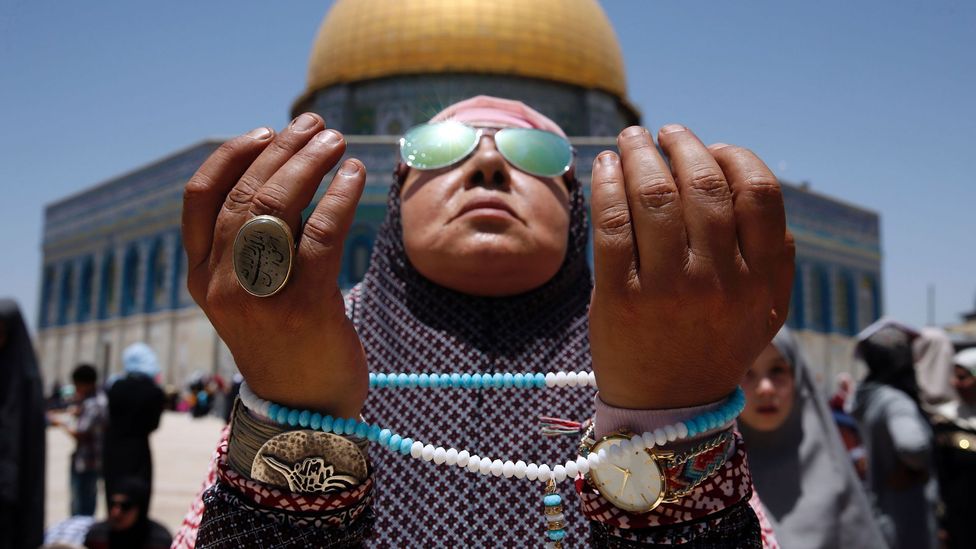 |
| (Image credit: Getty) |
How and why did religion evolve?
by Brandon Ambrosino
April 18, 2019
Can the roots of spiritual behaviours and feelings be found in other animals? In the first of a two-part special, Brandon Ambrosino examines the evolutionary origins of religion.
“This is my body.”
These words, recorded in the Gospels as being spoken by Jesus during the Last Supper, are said daily at Church services around the world before the communion meal is eaten. When Christians hear these words spoken in the present, we’re reminded of the past, which is always with us, which never goes away.
Just how much past are Christians reminded of? Certainly the last two millennia, which, in addition to devout celebrations of the Eucharist, are rife with doctrinal disputes, church splits, episodes of violence, excommunications, papal pronouncements, and various metaphysical debates, all revolving around the communion meal.
But we can rewind further back, to the development of the oral traditions that got fixed into texts that were incorporated into the canonical New Testament. We can also wonder about the historical meal on which the various Last Supper texts are based.
We can travel further back still, long before even the emergence of Christianity. After all, Jesus was a Jew, and so his act of breaking bread with the disciples reminds us of the entire history of the Jewish people, including their harrowing escape from Egyptian slavery and their receiving of the Torah at Sinai.
But we can go back even further. Any religious meal is, before it is anything else, a meal. It is an act of table-sharing, certainly an important ritual in the ancient Near East. Seder, and later communion, were “taken up” theologically and liturgically, but the positive feelings around table-sharing were already in place. They’d already been in place since the emergence of modern humans, about 200,000 years ago.
 |
The sharing of food is common in many world religions - and it may reflect some prehistoric preoccupations (Credit: Getty) |
And yet – Homo sapiens wasn’t the only species to discover the benefits of food-sharing. Neanderthals certainly pooled their resources, as did the several other Homo species dating back two million years.
“Think of uber pro-social hunter-gatherers having a meal,” one of my theology professors told me when I wondered about the deep evolutionary history behind the Eucharist. “The hunters feel proud to have done well and shared with their family; those who prepared the food are recognised and appreciated; everyone’s belly is getting filled and feeling good; and so many positive social interactions are taking place. No wonder so much mythological content is built up around the meal.”
But food-sharing even predates our Homo ancestors, and is currently observed in chimpanzees and bonobos. In fact, one recent paper even documented research of bonobos sharing food with bonobos outside of their own social group. Barbara Fruth, one of the study’s authors, told the digital magazine Sapiens that meal-sharing “must have its roots in our last common ancestor”. Based on the molecular clock, the last common ancestor, or LCA, of humans and Great Apes lived about 19 million years ago.
When I hear the words “This is my Body,” then, my mind immediately launches into a race to the evolutionary starting line, if you will. - Brandon Ambrosino
Deep religion
I begin with a discussion of the Eucharist because my particular religious tradition is Christian. But the point I’m making – that religious experiences emerge from very specific, very long histories – could be made with most religious phenomena. That’s because, in the words of the late sociologist Robert Bellah, “Nothing is ever lost.” History goes all the way back, and who and how and where we are now is the result of its winding forward. Any human phenomenon that exists is a human phenomenon that became what it is. This is no less true of religion.
If we’re going to think about the deep history of religion, then we need to be clear about what religion is. In his book The Bonobo and the Atheist, the primatologist Frans de Waal shares a funny story about participating in a panel hosted by the American Academy of Religion. When one participant suggested they start with defining religion, someone was quick to note that last time they tried to do that, “half the audience had angrily stomped out of the room”. Quipped de Waal: “And this in an academy named after the topic!”
Still, we need to start somewhere, so de Waal suggests this definition: religion is “the shared reverence for the supernatural, sacred, or spiritual as well as the symbols, rituals, and worship that are associated with it”. De Waal’s definition echoes one given by sociologist Émile Durkheim, who also emphasised the importance of shared experiences that “unite into one single moral community”.
The importance of shared experience can’t be overstated since, in the story we’re telling, the evolution of human religion is inseparable from the ever-increasing sociality of the hominin line. As Bellah points out, religion is as a way of being. We might also view it as a way of feeling, as a way of feeling together.
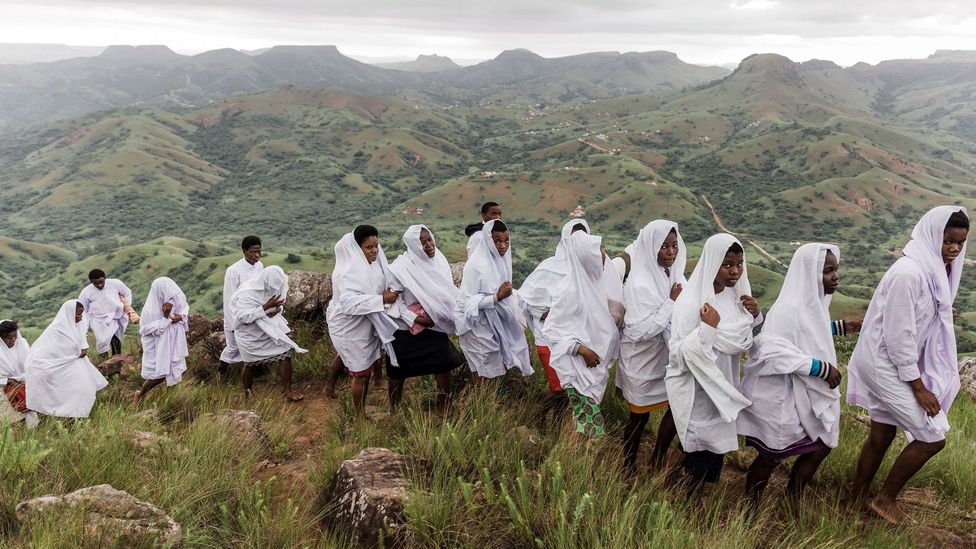 |
Followers of the Nazareth Baptist Church climb the Nhlangakazi Holy Mountain. Religious beliefs and rituals help to unite groups of individuals (Credit: Getty) |
While much of the scientific study of religion is on theology-based doctrinal religions, the evolutionary psychologist Robin Dunbar thinks this is a narrow way of studying the phenomenon because it “completely ignores the fact that for most of human history religions have had a very different shamanic-like form that lacks gods and moral codes”. (By shamanic, Dunbar means religions of experience that commonly involve trance and travel in spirit worlds.) While the theology-based forms are only a few thousand years old and characteristic of post-agricultural societies, Dunbar argues that the shamanic forms date back 500,000 years. These, he claims, are characteristic of hunter-gatherers.
If we want to understand how and why religion evolved, Dunbar says we need to start out by examining religions “with the cultural accretions stripped away”. We need to focus less on questions about Big Gods and creeds, and more on questions about the capacities that emerged in our ancient ancestors that allowed them to achieve a religious way of being together.
Adaptation or by-product?
All societies, after all, seem to have religions of some sort. “There are no exceptions to this,” de Waal told me over the phone.
"If all societies have religion, it must have
a social purpose" – Frans de Waal
There are two major perspectives on why this might be. One is called functionalism or adaptationism: the idea that religion brings positive evolutionary benefits, which are most often framed in terms of its contribution to group living. As de Waal puts it: “If all societies have [religion], it must have a social purpose.”
Others take the view that religion is a spandrel, or by-product of evolutionary processes. The word spandrel refers to an architectural shape that emerges as a by-product between arches and ceiling. Religion, on this interpretation, is akin to a vestigial organ. Perhaps it was adaptive in the environments it originally evolved in, but in this environment it’s maladaptive. Or perhaps religious beliefs are the result of psychological mechanisms that evolved to solve ecological problems unrelated to religion. Either way, evolution didn’t “aim” at religion; religion just emerged as evolution “aimed” at other things.
While folks on both sides of this debate have their reasons, it seems unhelpful to frame the evolution of religion in such either/or terms. Something that was merely a by-product of a blind evolutionary process could well be taken up by human beings to perform a specific function or solve a specific problem. (Read about what the future of religion could be like.)
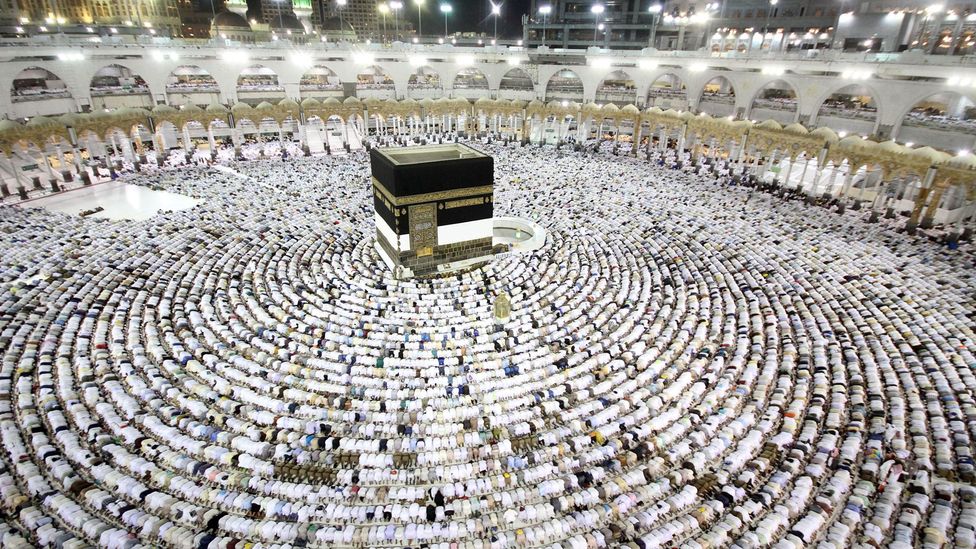 |
Muslim worshippers perform the evening (Isha) prayers at the Kaaba. Emotions such as awe, loyalty, and love are central to many religious celebrations (Credit: Getty) |
This can be true for many behaviours – including music – but religion presents a particular puzzle, since it often involves extremely costly behaviours, such as altruism and, at times, even self-sacrifice.
For this reason, some theorists such as Dunbar argue that we should also look beyond the individual to the survival of the group.
This is known as multilevel selection, which “recognises that fitness benefits can sometimes accrue to individuals through group-level effects, rather than always being the direct product of the individual’s own actions”, as Dunbar defines it.
An example is cooperative hunting, which enables groups to catch bigger prey than any members could catch as individuals. Bigger prey means more for me, even if I have to share the meat (since the animal being shared is already larger than anything I could catch alone). Such group-level processes “require the individual to be sensitive to the needs of other members of the group”, says Dunbar.
There is no history of the religion of an individual creature. Our story is about us.
Feeling first
If we are to understand religion, then, we first need to look back into your deep history to understand how human ancestors evolved to live in groups in the first place.
We are, after all, descended from a long line of ancestral hominoids with “weak social ties and no permanent group structures”, says Jonathan Turner, author of The Emergence and Evolution of Religion. That leads Turner to what he considers the million-dollar question: “How did Darwinian selection work on the neuroanatomy of hominins to make them more social so they could generate cohesive social bonds to form primary groups?” he asked me on the phone. “That’s not a natural thing for apes.”
Our ape line evolved from our last common ancestor around 19 million years ago. Orangutans broke away about 13-16 million years ago, while the gorilla line branched away about 8-9 million years ago. The hominin line then branched into two about 5-7 million years ago, with one line leading to the chimpanzees and bonobos, and the other leading to us. We modern humans share 99% of our genes with living chimpanzees – which means we’re the two most closely related apes in the whole line.
Human religion emerges out of our increased capacity for sociality
The similarities between humans and chimps are well known, but one important difference has to do with group size. Chimpanzees, on average, can maintain a group size of about 45, says Dunbar. “This appears to be the largest group size that can be maintained through grooming alone,” he says. In contrast, the average human group is about 150, known as Dunbar’s Number. The reason for this, says Dunbar, is that humans have the capacity to reach three times as many social contacts as chimps for a given amount of social effort. Human religion emerges out of this increased capacity for sociality.
How come? As our ape ancestors moved from receding forest habitats to more open environments, like the savannahs of eastern and southern Africa, Darwinian pressures acted on them to make them more social for increased protection from predators and better access to food; it also made it easier to find a mate. Without the ability to maintain new structures – like small groups of five or six so-called nuclear families, says Turner – these apes wouldn’t have been able to survive.
So how did nature achieve this socialisation process? Turner says the key isn’t with what we typically think of as intelligence, but rather with the emotions, which was accompanied by some important changes to our brain structure. Although the neocortex figures prominently in many theories of the evolution of religion, Turner says the more important alterations concerned the subcortical parts of the brain, which gave hominins the capacity to experience a broader range of emotions. These enhanced emotions promoted bonding, a crucial achievement for the development of religion.
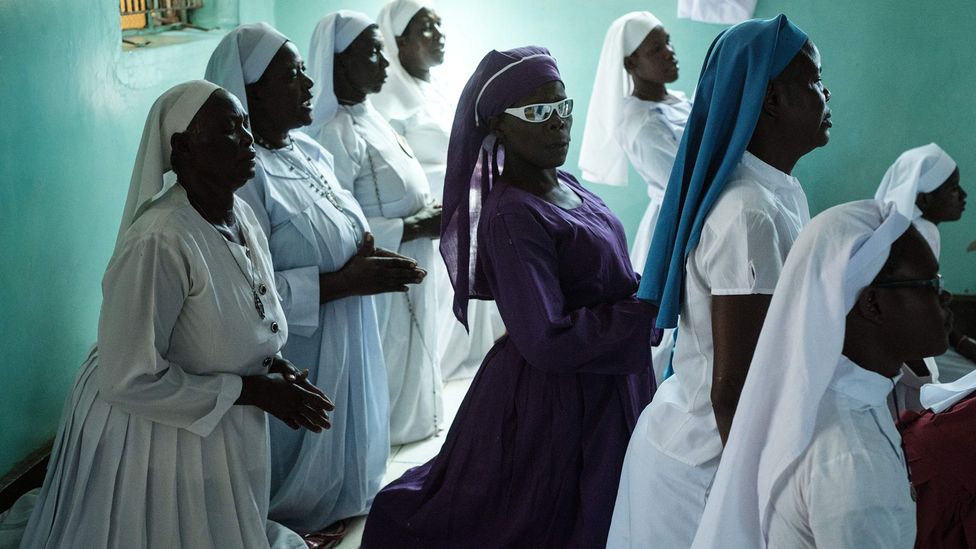 |
Complex religious feelings are often the combination of many emotions. Awe, for instance, is a heady mix of fear and happiness (Credit: Getty) |
The process of subcortical enhancement Turner refers to dates to about 4.5 million years ago, when the first Australopithecine emerged. Initially, says Turner, selection increased the size of their brains about 100 cubic centimetres (cc) beyond that of chimpanzees, to about 450 cc (in Australopithecus afarensis). For the sake of comparison, this is smaller than later hominins – Homo habilis had a cranial capacity of 775 cc, while Homo erectus was slightly larger at 800-850. Modern humans, in contrast, boast a brain size much bigger than any of these, with a cranial capacity of up to 1,400 cc.
It is in the story of how these [subcortical] mechanisms evolved that, ultimately, the origins of religion are to be discovered – Jonathan Turner
But the comparably smaller brain size doesn’t mean that nothing was happening to the hominin brain. Brain size is measured by an endocast, but Turner says these do not reflect the subcortical enhancement that was occurring between the emergence of Australopiths (around 4 million years ago) and Homo erectus (1.8 million years ago). “It is in the story of how these [subcortical] mechanisms evolved that, ultimately, the origins of religion are to be discovered.”
Although the neocortex of humans is three times the size of apes’, the subcortex is only twice as big – which leads Turner to believe that the enhancement of hominin emotion was well underway before the neocortex began to grow to its current human size.
Here’s how nature pulled it off. You’ve probably heard talk of the so-called four primary emotions: aggression, fear, sadness, and happiness. Notice anything about that list? Three of the emotions are negative. But the promotion of solidarity requires positive emotions – so natural selection had to find a way to mute the negative emotions and enhance the positive ones, Turner says. The emotional capacities of great apes (particularly chimpanzees) were already more elaborate than many other mammals, so selection had something to work with.
At this point in his argument, Turner introduces the concept of first- and second-order elaborations, which are emotions that are the result of a combinations of two or more primary emotions. So, for example, the combination of happiness and anger generates vengeance, while jealousy is the result of combining anger and fear. Awe, which figures majorly in religion, is the combination of fear and happiness. Second-order elaborations are even more complex, and occurred in the evolution from Homo erectus (1.8 million years ago) to Homo sapiens (about 200,000 years ago). Guilt and shame, for example, two crucial emotions for the development of religion, are the combination of sadness, fear, and anger.
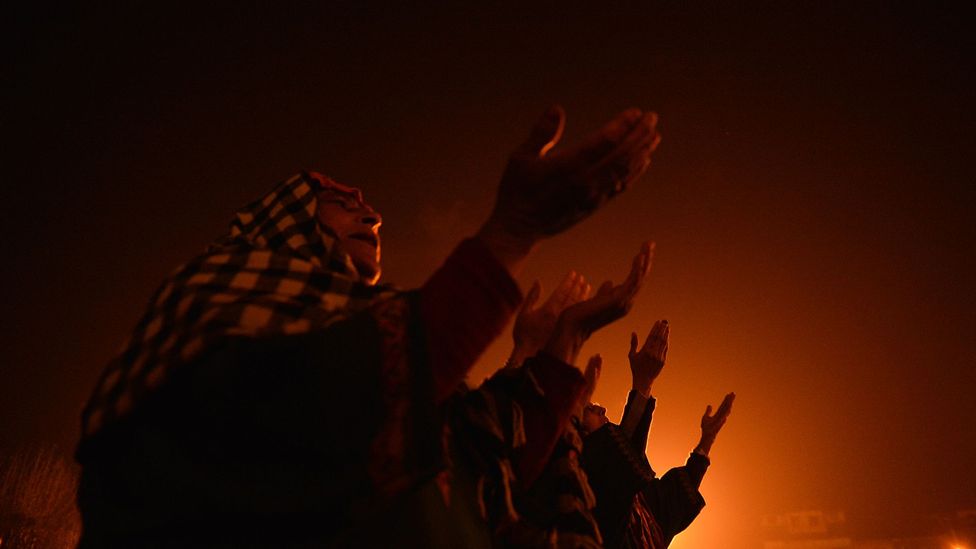 |
Kashmiri Muslims celebrate Eid-e-Milad-un-Nabi, the anniversary of the Prophet's birth (Credit: Getty) |
It’s difficult to imagine religion without the capacity to experience these emotional elaborations for the same reason it’s difficult to imagine close social groups without them: such an emotional palette binds us to one another at a visceral level. “Human solidarities are only possible by emotional arousal revolving around positive emotions – love, happiness, satisfaction, caring, loyalty – and the mitigation of the power of negative emotions, or at least some negative emotions,” says Turner. “And once these new valences of positive emotions are neurologically possible, they can become entwined with rituals and other emotion-arousing behaviours to enhance solidarities and, eventually, produce notions of power gods and supernatural forces.”
Not to jump ahead too far, but it’s important to understand how pivotal feeling is in the evolution of religion. As far as Darwin was convinced, there wasn’t any difference between religious feeling and any other feeling. “It is an argument for materialism,” he wrote in a journal entry, “that cold water brings on suddenly in head, a frame of mind, analogous to those feelings, which may be considered as truly spiritual.” If this is true, then that means the causes of religious feelings can be pinpointed and studied just like any other feeling.
Ritual
As selection worked on existing brain structures, enhancing emotional and interpersonal capacities, certain behavioural propensities of apes began to evolve. Some of the propensities that Turner lists as already present in apes include: the ability to read eyes and faces and to imitate facial gestures; various capacities for empathy; the ability to become emotionally aroused in social settings; the capacity to perform rituals; a sense of reciprocity and justice; and the ability to see the self as an object in an environment. An increase in the emotional palette available to apes would, according to Turner, result in an increase in all of these behavioural capacities.
Though many if not all of these behaviours have been documented in apes, I want to concentrate on two of them – ritual and empathy – without which religion would be unthinkable.
In archival footage, primatologist and anthropologist Jane Goodall describes the well-known waterfall dance which has been widely observed in chimpanzees. Her comments are worth quoting at length:
When the chimpanzees approach, they hear this roaring sound, and you see their hair stands a little on end and then they move a bit quicker. When they get here, they’ll rhythmically sway, often upright, picking up big rocks and throwing them for maybe 10 minutes. Sometimes climbing up the vines at the side and swinging out into the spray, and they’re right down in the water which normally they avoid. Afterwards you’ll see them sitting on a rock, actually in the stream, looking up, watching the water with their eyes as it falls down, and then watching it going away. I can’t help feeling that this waterfall display or dance is perhaps triggered by feelings awe, wonder that we feel.
The chimpanzee’s brain is so like ours: they have emotions that are clearly similar to or the same as those that we call happiness, sad, fear, despair, and so forth – the incredible intellectual abilities that we used to think unique to us. So why wouldn’t they also have feelings of some kind of spirituality, which is really being amazed at things outside yourself?
Goodall has observed a similar phenomenon happen during a heavy rain. These observations have led her to conclude that chimpanzees are as spiritual as we are. “They can’t analyse it, they don’t talk about it, they can’t describe what they feel. But you get the feeling that it’s all locked up inside them and the only way they can express it is through this fantastic rhythmic dance.” In addition to the displays that Goodall describes, others have observed various carnivalesque displays, drumming sessions, and various hooting rituals.
The roots of ritual are in what Bellah calls “serious play” – activities done for their own sake, which may not serve an immediate survival capacity, but which have “a very large potentiality of developing more capacities”. This view fits with various theories in developmental science, showing that playful activities are often crucial for developing important abilities like theory of mind and counterfactual thinking.
Play, in this evolutionary sense, has many unique characteristics: it must be performed “in a relaxed field” – when the animal is fed and healthy and stress-free (which is why it is most common in species with extended parental care). Play also occurs in bouts: it has a clear beginning and ending. In dogs, for example, play is initiated with a “bow”. Play involves a sense of justice, or at least equanimity: big animals need to self-handicap in order to not hurt smaller animals. And it might go without saying, but play is embodied.
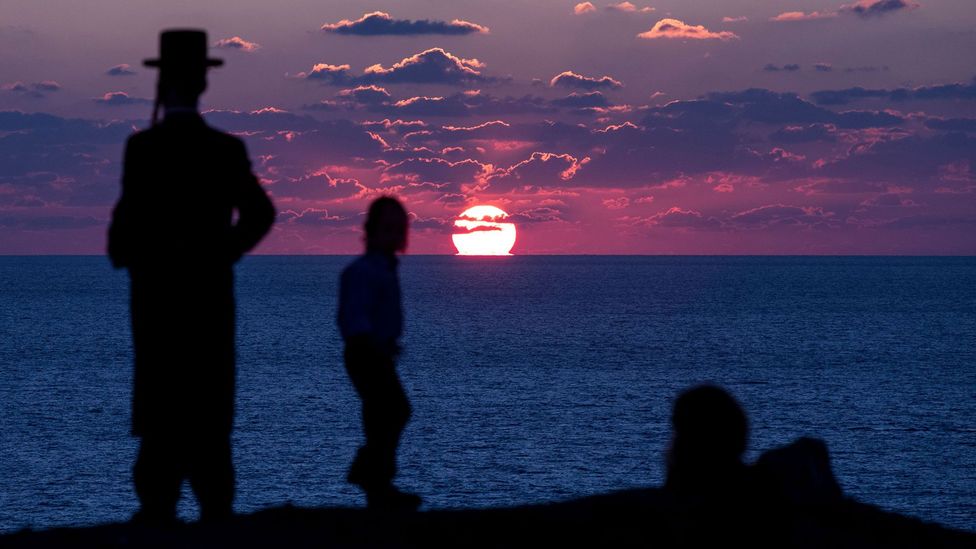 |
Ultra-Orthodox Jewish men take part in the Tashlich ritual, during which sins are cast into the water to the fish (Credit: Getty) |
Now compare that to ritual, which is enacted, which is embodied. Rituals begin and end. They require both shared intention and shared attention. There are norms involved. They take place in a time within time – beyond the time of the everyday. (Think, for example, of a football game in which balls can be caught “out of bounds” and time can be paused. We regularly participate in modes of reality in which we willingly bracket out “the real world”. Play allows us to do this.) Most important of all, says Bellah, play is a practice in itself, and “not something with an external end”.
Bellah calls ritual “the primordial form of serious play in human evolutionary history”, which means that ritual is an enhancement of the capacities that make play first possible in the mammalian line. There is a continuity between the two. And while Turner acknowledges it might be pushing it to refer to a chimpanzee waterfall dance or carnival as Ritual with a capital R, it is possible to affirm that “these ritual-like behavioural propensities suggest that some of what is needed for religious behaviour is part of the genome of chimpanzees, and hence, hominins”.
Empathy
The second trait we must consider is empathy. Empathy is not primarily in the head. It’s in the body – at least that’s how it started. It began, writes de Waal, “with the synchronisation of bodies, running when others run, laughing when others laugh, crying when others cry, or yawning when others yawn”.
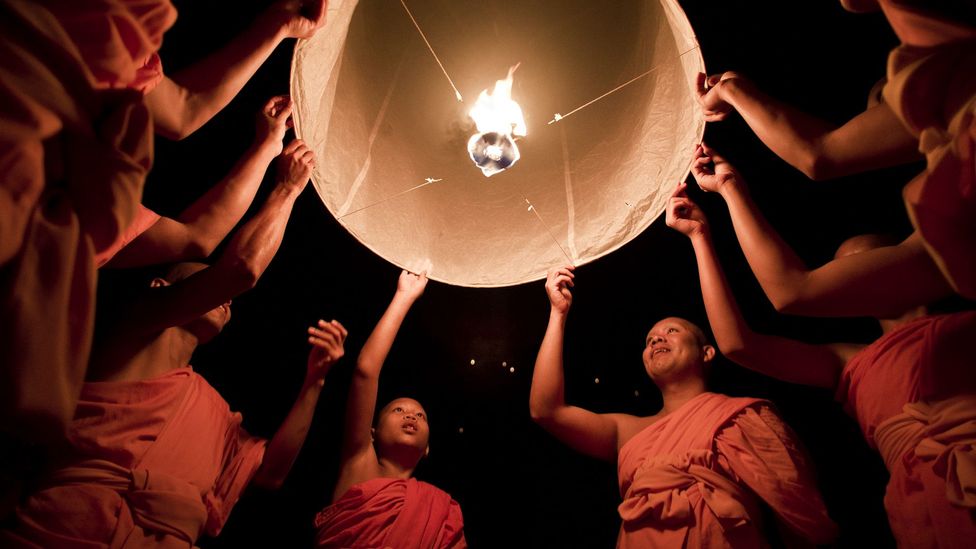 |
Buddhist monks launch a sky lantern during the Yee Peng Festival in Chiang Mai. The ritual symbolises the release of kindness and goodwill (Credit: Getty) |
Empathy is absolutely central to what we call morality, says de Waal. “Without empathy, you can’t get human morality. It makes us interested in others. It makes us have an emotional stake in them.” If religion, according to our definition, is a way of being together, then morality, which instructs us as to the best ways to be together, is an inextricable part of that.
De Waal has been criticised over the years for offering a rose-coloured interpretation of animal behaviour. Rather than view animal behaviour as altruistic, and therefore springing from a sense of empathy, we should, these wise scientists tell us, see this behaviour for what it is: selfishness. Animals want to survive. Period. Any action they take needs to be interpreted within that matrix.
But this is a misguided way of talking about altruism, de Waal says.
“We see animals want to share food even though it costs them. We do experiments on them and the general conclusion is that many animals’ first tendency is to be altruistic and cooperative. Altruistic tendencies come very naturally to many mammals.”
But isn’t this just self-preservation? Aren’t the animals just acting in their own best interests? If they behave in a way that appears altruistic, aren’t they just preparing (so to speak) for a time when they will need help? “To call that selfish,” says an incredulous de Waal, “because in the end of course these pro-social tendencies have benefits?” To do that, he says, is to define words into meaninglessness.
Yes, of course there are pleasurable sensations associated with the action of giving to others. But evolution has produced pleasurable sensations for behaviours we need to perform, like sex and eating and female-nursing. The same is true for altruism, says de Waal. That does not fundamentally alter what the behaviour is.
Such a hard and fast line between altruism and selfishness, then, is naive at best and deceptive at worst. And we can see the same with discussions of social norms. Philosophers such as David Hume have made the distinction between what a behaviour “is” and what it “ought” to be, which is a staple of ethical deliberation. An animal may perform the behaviour X, but does it do so because it feels it should do so – thanks to an appreciation of a norm?
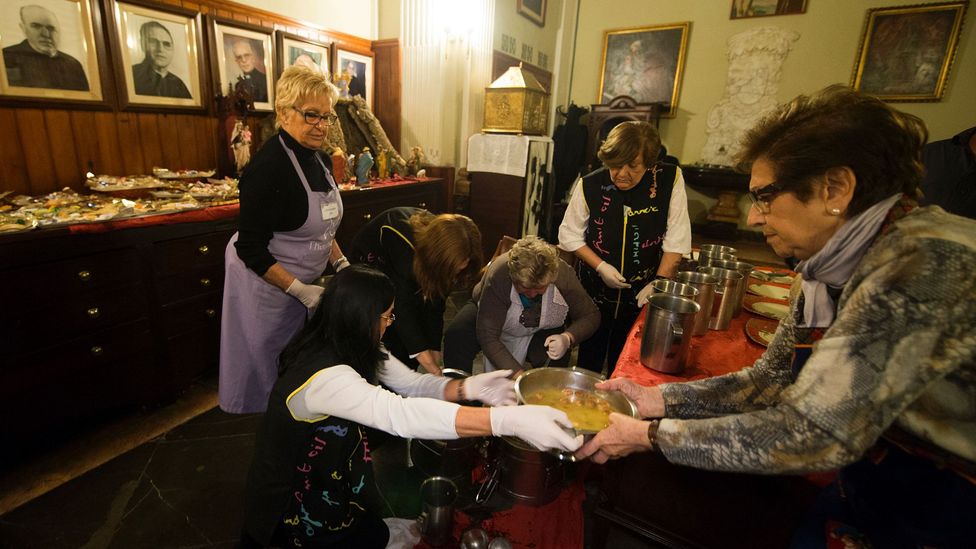 |
Women prepare food for the homeless during a charity Christmas dinner (Credit: Getty) |
This distinction is one that de Waal has run into from philosophers who say that any of his observations of empathy or morality in animals can’t possibly tell him about whether or not they have norms. De Waal disagrees, pointing out that animals do recognise norms:
The simplest example is a spider web or nest. If you disturb it, the animal’s going to repair that right away because they have a norm for how it should look and function. They either abandon it, or start over and repair it. Animals are capable of having goals and striving towards them. In the social world, if they have a fight, they come together and try to repair damage. They try to get back to an ought state. They have norm of how this distribution should be. The idea that normativity is [restricted to] humans is not correct.
In the Bonobo and the Atheist, de Waal argues that animals seem to possess a mechanism for social repair. “About 30 different primate species reconcile after fights, and that reconciliation is not limited to the primates. There is evidence for this mechanism in hyenas, dolphins, wolves, domestic goats.”
He also finds evidence that animals “actively try to preserve harmony within their social network … by reconciling after conflict, protesting against unequal divisions, and breaking up fights among others. They behave normatively in the sense of correcting, or trying to correct, deviations from an ideal state. They also show emotional self-control and anticipatory conflict resolution in order to prevent such deviations. This makes moving from primate behaviour to human moral norms less of a leap than commonly thought.”
There’s obviously a gap between primate social repair and the institutionalisation of moral codes that lie at the heart of modern human societies. Still, says de Waal, all of these “human moral systems make use of primate tendencies”.
How far back to these tendencies go? Probably, like those capacities that allowed for play (and ultimately ritual), to the advent of parental care. “During 200 million years of mammalian evolution, females sensitive to their offspring out-reproduced those who were cold and distant,” says de Waal. Of course, nurturing is arguably seen in species of fish, crocodiles, and snakes, but the nurturing capabilities of mammals is really a giant leap forward in the evolutionary story.
The early dawn of religion
Our religious services of today may seem worlds away from the mammalian play and empathy that emerged in our deep past, and indeed institutionalised religion is much more advanced than a so-called waterfall dance. But evolution teaches us that complex, advanced phenomena develop from simple beginnings. As Bellah reminds us, we don’t come from nowhere. “We are embedded in a deep biological and cosmological history.”
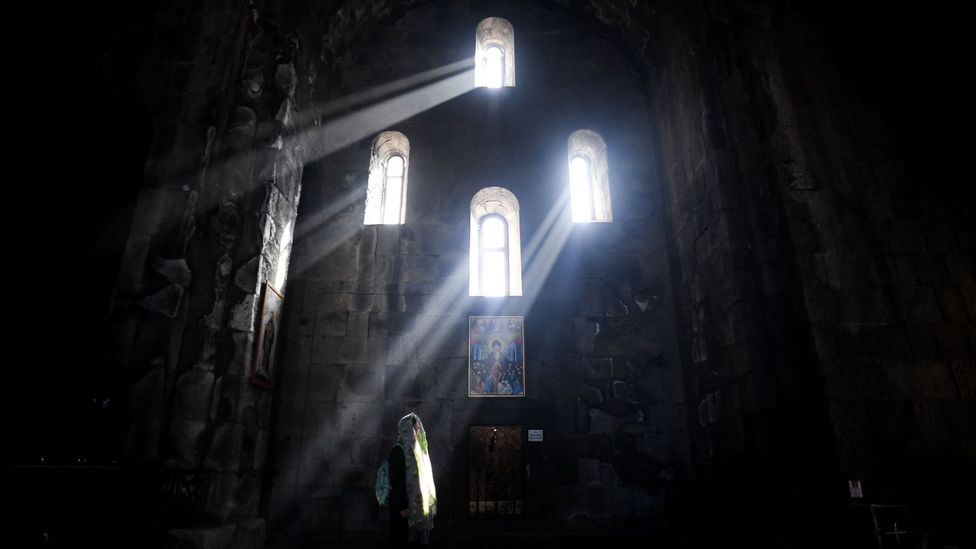 |
Our religious services of today seem worlds away from their ancient origins, but like all human behaviours, they are deeply embedded in evolutionary history (Credit: Getty) |
As the ape line evolved from our last common ancestor in more open environments, it was necessary to pressure apes, who prefer to go it alone, to form more lasting social structures. Natural selection was able to accomplish this astonishing feat by enhancing the emotional palettes available that had long been available to our ancestors. With a broader set of emotions, the hominin brain was then able to enhance some of its capabilities, some of which quite naturally lent themselves a religious way of being. As these capacities got more acutely enhanced with the growth of the Homo brain and the development of the neocortex, behaviours such as play and ritual entered a new phase in hominin development, becoming the raw materials out of which cultural evolution would begin to institutionalise religion.
And though this history doesn’t determine us – for with each new phase in life’s story comes greater power of agency – this bio-cosmological history influences everything we do and are. Even the most seemingly autonomous human decision is made from within history. That’s the big picture here. That’s what we’ve been keeping in mind as we made our way back in time to the evolutionary seeds that would eventually – and quite slowly – blossom into human religion.
Though I often think theologically about the words “This is my body,” I shouldn’t overlook the basic fact that communion is about bodies – mine, yours, ours. Religion is an embodied phenomenon because the human religious way of being has evolved for millions of years as the bodies of our ancestors interacted with the other bodies around them. Whether or not one takes communion or even feels religious, we are at all times navigating our social worlds with our evolved capacities to play, to empathise, and to celebrate rituals with each other.
--
Brandon Ambrosino has written for the New York Times, Boston Globe, The Atlantic, Politico, Economist, and other publications. He lives in Delaware. This is the first of a two-part special examining the evolutionary roots of religion.



No comments:
Post a Comment